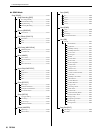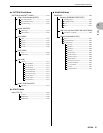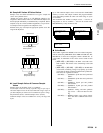
2. RS7000 Internal Structure
RS7000 63
1
Basic
The [STORE] button is used to store the current scene or mute
settings to one of the 5 available memory locations: [MEMORY
1] ~ [MEMORY 5]. The selected type of data is stored when a
scene/mute memory button — [MEMORY 1] ~ [MEMORY 5]
— is pressed while the [STORE] button is held. When pressed
alone the [MEMORY 1] ~ [MEMORY 5] buttons recall the
stored scene or mute data.
Store and recall operations cannot be carried out in the sampling
mode.
● Sequencer Buttons
These control the basic functions of the sequencer block.
[ ].....................................Goes directly to the top measure of
the current pattern or song.
[ ]...................................Moves forward one measure when
pressed briefly, or scrolls forward
continuously (fast forward) when
held.
[ ]...................................Moves back one measure when
pressed briefly, or scrolls backward
continuously (fast reverse) when
held.
[ ] (REC)........................Switches to the phrase or song
recording display.
[ ] (STOP).....................Stops pattern or song playback or
recording.
[ ] (PLAY) ......................Starts pattern or song playback, and
starts phrase or song recording.
Arpeggiator
This function automatically plays notes and chords played on the
keyboard as arpeggios. In addition to driving the tone generator
block, arpeggio data can be sent to the sequencer block and
recorded as sequence data to a phrase or song, or transmitted to
external equipment via the MIDI OUT connectors.
Arpeggios are also sometimes known as “broken chords”, and are
used frequently in modern dance and techno styles. To play auto-
mated arpeggios press the [ARPEGGIO ON] button so that its
indicator lights and play a chord on the keyboard.
Effects
The effect block can be used to apply effect processing to the out-
put of the tone generator block. Three effect stages are provided
— reverb, delay/chorus, and variation — and different effects can
be applied to each track.
● Reverb Effect
This effect stage is especially for reverb. It can add a natural
sense of ambience and space to the sound.
12 types of reverb are provided:
See the “Effect List” on Page 313 for details.
● Delay/Chorus Effects
25 delay and chorus effects are provided:
See the “Effect List” on Page 313 for details.
● Variation Effects
100 variation effects are provided, including reverb, distortion,
overdrive, and much more:
See the “Effect List” on Page 313 for details.
Master EQ & Effects
This block applies equalization and effects to the final stereo out-
put signal. This block is ideal for “mastering” the overall RS7000
sound.
8 Effect types are provided.
See the “Effect List” on Page 313 for details.
Memory Configuration
The RS7000 internal memory can be categorized as System
Memory, Preset Memory, and User memory.
● System Memory
The RS7000 operating environment is retained in this memory.
System setup, MIDI setup, and MIDI filter setup parameters.
● Preset Memory
This is a read-only memory (it can’t be erased or rewritten) that
contains the preset phrases and voices.
● User Memory
The user memory is a volatile memory (the contents can be
erased and rewritten) which is used to retain recorded phrases,
patterns, and samples. A memory protect function is provided to
prevent accidental erasure. The memory can hold up to 128 local
samples for each style or song, 128 common samples, 5 scene
and 5 mute setups, 256 user phrases for each style, 1024 patterns
(64 styles × 16 sections), 20 pattern chains, and 20 songs.
The user memory is empty when the unit is shipped from the fac-
tory.
CAUTION
All user memory data is erased when the power
is turned off. Be sure to save data you want to
keep to a memory card or an external SCSI
disk.


















